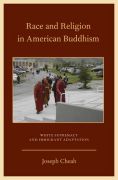
Race and religion in American Buddhism: white supremacy and immigrant adaptation
Cheah, Joseph
In Race and Religion in American Buddhism, Joseph Cheah examines how the racial ideology of white supremacy has been played out in the two different ways by which convert Buddhists and sympathizers, and Burmese ethnic Buddhists haveadapted Buddhist religious practices to the American context. When the first wave of Burmese immigrant Buddhists set foot on American soil in the late 1960s, they came into contact with a variety of forms of Buddhism not found in their native Burma. One of these forms was a white or convert Buddhism, whose legacy includes the specter of an Orientalist and racist past, often hardly acknowledged, yet rarely if ever entirely absent from the discourse within Euro-American Buddhism. The legacy of Orientalism in convert Buddhism can be traced totheworks of Western Orientalists in the middle and late Victorian era. Stemming in part from Orientalist racial projects, vestiges of white supremacy ideologycan still be detected today in the controversy surrounding who represents "American Buddhism" and the smorgasbord of approaches in Buddhistpractices that are taken for granted in many meditation centers, hospitals, and other institutions. The prevailing ideology of white supremacy operative inthese and other contexts influences the ways in which Buddhist practices havebeen adapted by both convert and ethnic Buddhist communities. Within the scope of Buddhism as both a religion and a practice, focusing primarily on the Theravada tradition, Joseph Cheah examines in Race and Religion in American Buddhism rearticulations ofAsian Buddhist practices through the lens of race and racialization. Chapter One: IntroductionChapter Two: Colonial Legacy of White Supremacy in American BuddhismChapter Three: Buddhist Modernism and the American Vipassana MovementChapter Four: Adaptation of Vipassana Meditation by Convert Buddhists and SympathizersChapter Five: Assimilationist Paradigm and Burmese AmericansChapter Six: Monastic and Domestic SettingsChapter Seven: Burmese Loyalty Structure of the Dual Domination ParadigmChapter Eight: ConclusionBibliographyIndex
- ISBN: 978-0-19-975628-5
- Editorial: Oxford University
- Encuadernacion: Cartoné
- Páginas: 192
- Fecha Publicación: 17/11/2011
- Nº Volúmenes: 1
- Idioma: Inglés
